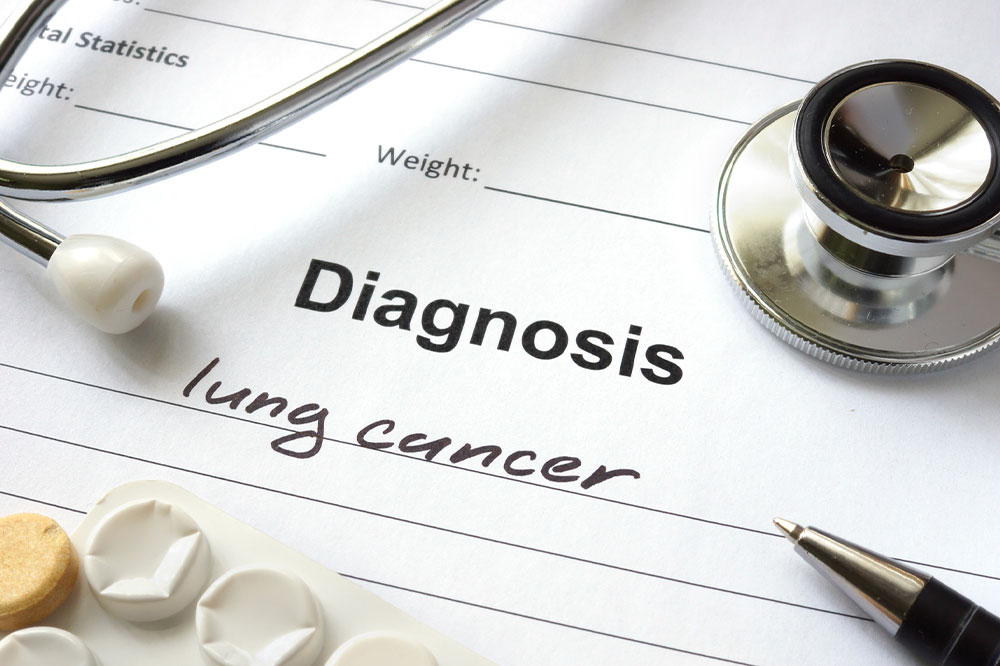An Overview Of Lung Cancer
The human body is made up of cells. The cells grow and divide in order to produce new cells. When cells become old or get damaged, they usually die and the new cells take over. However, when genetic changes impede this process, uncontrollable growth of cells occurs. A tumor may form if the cells come together to form a mass. Thus, cancer is a disease that occurs when the cells in the body grow uncontrollably.

Lung cancer is one of the most dangerous cancers that affect both men and women in the country. It surpassed breast cancer to be the most dangerous and terminal cancer in 1987.
Below is an overview of what is lung cancer, its early symptoms, the risk factors, diagnosis, and more.
What is lung cancer?
- Lung cancer begins in the lungs and if it is not detected early it may spread to the lymph nodes and/or other organs in the body, including the brain.
- Similarly, cancer may spread from other organs to the lungs. This process of cancer spreading from one organ to another is known as metastases.
- Lung cancer can occur in two forms, small cell cancer or non-small cell cancer. Each is very different from the other; therefore, the treatment procedures also vary.
- Non-small cell cancers are more common than the small cell type.
What are the early symptoms of lung cancer?
In its early stages, lung cancer may not show any symptoms. However, if present it may show symptoms, which may also vary from one person to another. Some of the common symptoms of an early stage of lung cancer include:
- Infections – One of the common symptoms of early stages of lung cancer is persistent and recurring infections, such as pneumonia and bronchitis.
- Fatigue – Feeling constantly tired without strenuous activities and having constant weakness could be a sign of lung cancer.
- Weight loss – A sudden loss in excessive weight that can’t be explained is a common symptom of most types of cancer.
- Coughing – A constant cough that does not get cured or turns into a chronic smoker’s cough is a symptom of lung cancer. A smoker’s cough often is more persistent and/or painful. Apart from this, if the coughing leads to coughing up sputum that is rust colored or coughing up blood should be the most important signal that something is not right, and one needs to visit a doctor immediately.
- Difficulty in breathing – Stridor (noisy breathing), breathlessness, and/or wheezing could be symptoms of early stages of lung cancer.
What are the risk factors for lung cancer?
- Substances like arsenic, asbestos, diesel exhaust, and some forms of chromium or silica can also cause lung cancer. People exposed to these substances for a long period of time have high chances of suffering from lung cancer.
- Smoking is one of the main risk factors for lung cancer. Research information on lung cancer shows that 80% to 90% of lung cancers are caused due to smoking. Tobacco is a carcinogen and any form of tobacco increases the chance of lung cancer. However, it is not limited to just lungs, tobacco smoke or its products can cause many other types of cancer.
- Passive smoking or second-hand smoking is another risk factor associated with lung cancer. Being in the proximity of a smoker and inhaling the smoke can increase a person’s chance of cancer. Several lung cancer resources state that 2 out of 5 non-smoking adults, in the country, who inhale second-hand smoke suffer from lung cancer.
How is lung cancer diagnosed?
People who may be at a higher risk of lung cancer may get themselves tested with their doctors on a regular basis. This rule holds good for people who smoke or work in environments where they may be exposed to carcinogenic substances. Some of the methods used by doctors to diagnose lung cancer include:
- Imaging tests – Imaging tests like X-rays of the chest, CT scans, MRI scans, and PET scans may be conducted to check for abnormalities in the lungs, such as a mass growth or a abnormal nodule. CT scans can help in detecting small lesions in the lungs.
- Sputum cytology – If a person is suffering from a persistent cough and is spitting sputum, a sputum cytology is conducted. A sputum cytology is used to detect cancerous cells by looking at the sputum under a microscope.
- Biopsy (tissue sample) – Removing a sample of abnormal cells from a cluster is known as a biopsy. The doctors may perform using a bronchoscopy. Bronchoscopy is the process in which the doctor passes a lighted tube down the patient’s throat into the lungs and examines the abnormal cells. Upon analyzing the abnormal cells, a diagnosis is made.
What is the treatment procedure for lung cancer?
- Lung cancer is treated based on the type and stage of cancer. There is no single method to treat it.
- Non-small cell cancer can be treated using surgery followed by chemotherapy, radiation therapy, targeted therapy, or combinations of different therapies.
- Whereas, chemo and radiation therapy is often used for treating small cell lung cancer.
How does a patient cope with life after lung cancer treatment?
- As per lung cancer research, patients who have been diagnosed or treated for lung cancer need a lot of support to help them cope with life.
- Cancer is overwhelming and the treatment is equally painstaking. The patient needs to have a proper support system in place to help them through the treatment procedures as well as the recovery.
- Apart from family, there are many support groups, wherein the patient can find solace with patients who have been suffering and/or have been treated for lung cancer.




